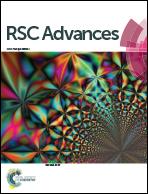A convenient synthetic route to sulfonimidamides from sulfonamides†
Abstract
Sulfonimidamides were prepared in a one-pot transformation from sulfonamides, through nucleophilic substitution of sulfonimidoyl chlorides formed in situ with different amines. This methodology represents a convenient, safe, and easily accessible synthetic route to sulfonimidamides.


 Please wait while we load your content...
Please wait while we load your content...